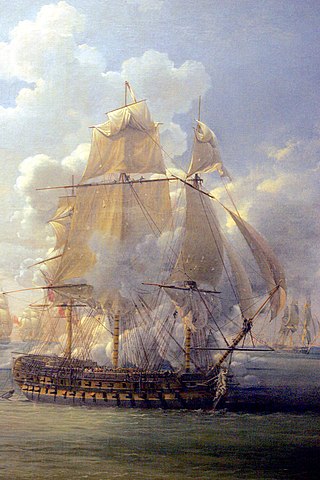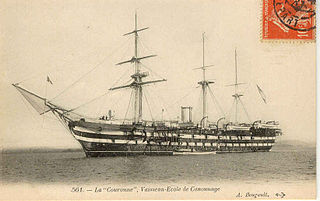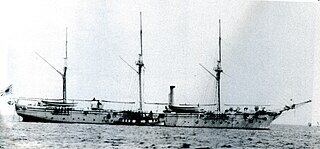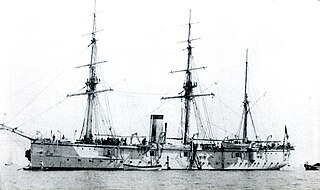
A ship of the line was a type of naval warship constructed during the Age of Sail from the 17th century to the mid-19th century. The ship of the line was designed for the naval tactic known as the line of battle, which depended on the two columns of opposing warships maneuvering to volley fire with the cannons along their broadsides. In conflicts where opposing ships were both able to fire from their broadsides, the opponent with more cannons firing – and therefore more firepower – typically had an advantage. Since these engagements were almost invariably won by the heaviest ships carrying more of the most powerful guns, the natural progression was to build sailing vessels that were the largest and most powerful of their time.

USS Pennsylvania was a three-decked ship of the line of the United States Navy, rated at 130 guns, and named for the state of Pennsylvania. She was the largest United States sailing warship ever built, the equivalent of a first-rate of the British Royal Navy. Authorized in 1816 and launched in 1837, her only cruise was a single trip from Delaware Bay through Chesapeake Bay to the Norfolk Navy Yard. The ship became a receiving ship, and during the Civil War was destroyed.

An ironclad is a steam-propelled warship protected by iron or steel armor plates, constructed from 1859 to the early 1890s. The ironclad was developed as a result of the vulnerability of wooden warships to explosive or incendiary shells. The first ironclad battleship, Gloire, was launched by the French Navy in November 1859 - narrowly pre-empting the British Royal Navy.

In the 18th century and most of the 19th, a sloop-of-war in the Royal Navy was a warship with a single gun deck that carried up to eighteen guns. The rating system covered all vessels with 20 guns and above; thus, the term sloop-of-war encompassed all the unrated combat vessels, including the very small gun-brigs and cutters. In technical terms, even the more specialised bomb vessels and fireships were classed as sloops-of-war, and in practice these were employed in the sloop role when not carrying out their specialised functions.

Steam frigates and the smaller steam corvettes, steam sloops, steam gunboats and steam schooners, were steam-powered warships that were not meant to stand in the line of battle. There were some exceptions like for example the French Napoléon class steam ship of the line was meant to stand in the line of battle, making it the world's first steam battleship. The first such ships were paddle steamers. Later on the invention of screw propulsion enabled construction of steam-powered versions of the traditional ships of the line, frigates, corvettes, sloops and gunboats.

USS Merrimack, also improperly Merrimac, was a steam frigate, best known as the hull upon which the ironclad warship CSS Virginia was constructed during the American Civil War. The CSS Virginia then took part in the Battle of Hampton Roads in the first engagement between ironclad warships.

USS Contoocook was a screw sloop-of-war built for the United States Navy during the American Civil War. She is named after a river and village in New Hampshire. She was launched 3 December 1864 at Portsmouth Navy Yard and commissioned 14 March 1868, commanded by Captain George Balch.

HMS Research was a small ironclad warship, converted from a wooden-hulled sloop and intended as an experimental platform in which to try out new concepts in armament and in armour. She was launched in 1863, laid up in 1878 and sold for breaking in 1884, having displayed serious limitations as a warship.

HMS Algerine was a Phoenix-class steel screw sloop of the Royal Navy. She was launched at Devonport in 1895, saw action in China during the Boxer Rebellion, and later served on the Pacific Station. She was stripped of her crew at Esquimalt in 1914, and transferred to the Royal Canadian Navy in 1917, being commissioned as HMCS Algerine. She was sold as a salvage vessel in 1919 and wrecked in 1923.

The French ironclad Couronne ("Crown") was the first iron-hulled ironclad warship built for the French Navy in 1859–1862. She was the first such ship to be laid down, although the British armoured frigate HMS Warrior was completed first. The ship participated in the Franco-Prussian War of 1870–1871, but saw no combat. She was served as a gunnery training ship from 1885 to 1908 before she was hulked the following year and became a barracks ship in Toulon. Couronne was scrapped in 1934, over 70 years after she was completed.

Amagi was a screw sloop in the early Imperial Japanese Navy, and was the third vessel built by the Yokosuka Naval Arsenal after its acquisition by the Meiji government. When built, Amagi was the largest warship yet produced domestically in Japan. Amagi was named after the Mount Amagi, in Shizuoka Prefecture, Japan.

Katsuragi (葛城) was the lead ship in the Katsuragi class of three composite hulled, sail-and-steam corvettes of the early Imperial Japanese Navy. The ship was named for a mountain located between Osaka and Nara prefectures.
USS Wanaloset, also spelled USS Wanalosett, was a proposed United States Navy screw sloop-of-war or steam frigate that appears never to have been laid down.
USS Watauga was a proposed United States Navy screw frigate that was never built.
USS Arapahoe was a proposed United States Navy screw sloop-of-war or steam frigate that was cancelled in 1866 without being completed.
USS Keosauqua was a proposed United States Navy screw sloop-of-war or steam frigate that was cancelled in 1866 without being completed.

The Rosario class was a class of seven screw-sloops of wooden construction built for the Royal Navy between 1860 and 1862. A further six vessels were ordered and laid down, but were cancelled in 1863 before launch. This was the last class of purely wooden sloops built for the Royal Navy.
HMS Bristol was the name ship of her class of wooden screw frigates built for the Royal Navy during the 1860s.

The Ister-class frigates were a group of five 36-gun screw frigates ordered for the Royal Navy in the early 1860s. Four of the ships were cancelled after they were laid down and HMS Endymion was the only ship completed.













